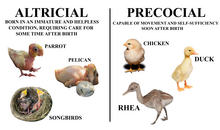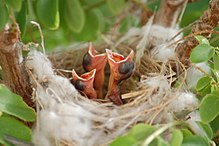Precociality and altriciality

In the
In fish, this often refers to the presence or absence of a stomach: precocial larvae have a stomach at the onset of first feeding whereas altricial fish do not.[1] Depending on the species, the larvae may develop a functional stomach during metamorphosis (gastric) or remain stomachless (agastric).


Altriciality
This section needs expansion. You can help by adding to it. (January 2022) |
Etymology
The word is derived from the Latin root alere, meaning "to nurse, to rear, or to nourish" and indicates the need for young to be fed and taken care of for a long duration.[2] By contrast, species whose young are immediately or quickly mobile are called precocial.
Precociality
Etymology
The word "precocial" is derived from the same root as precocious, from the Latin root praecox, meaning early maturity in both cases.[3]
Superprecociality
Extremely precocial species are called "superprecocial". Examples are the
Another example is the blue wildebeest, the calves of which can stand within an average of six minutes from birth and walk within thirty minutes;[6][7] they can outrun a hyena within a day.[8][9][10] Such behavior gives them an advantage over other herbivore species and they are 100 times more abundant in the Serengeti ecosystem than hartebeests, their closest taxonomic relative. Hartebeest calves are not as precocial as wildebeest calves and take up to thirty minutes or more before they stand, and as long as forty-five minutes before they can follow their mothers for short distances. They are unable to keep up with their mothers until they are more than a week old.[10]
Black mambas are highly precocial; as hatchlings, they are fully independent, and are capable of hunting prey the size of a small rat.[11]
Phylogeny
Precociality is thought to be ancestral in birds. Thus, altricial birds tend to be found in the most derived groups. There is some evidence for precociality in
Differences

In
A hastier alternative is employed by precocial animals, in which the young have open eyes, have hair or down, have large brains and are immediately mobile and somewhat able to flee from, or defend themselves against, predators. For example, with ground-nesting birds such as
The span between precocial and altricial species is particularly broad in
Precocial birds can provide protein-rich eggs and thus their young hatch in the fledgling stage – able to protect themselves from predators and the females have less post-natal involvement. Altricial birds are less able to contribute nutrients in the pre-natal stage; their eggs are smaller and their young are still in need of much attention and protection from predators. This may be related to
In birds, altricial young usually grow faster than precocial young. This is hypothesized to occur so that exposure to predators during the nestling stage of development can be minimized.[20]
In the case of mammals, it has been suggested that large, hearty adult body sizes favor the production of large, precocious young, which develop with a longer gestation period. Large young may be associated with migratory behavior, extended reproductive period, and reduced litter size. It may be that altricial strategies in mammals, in contrast, develop in species with less migratory and more territorial lifestyles, such as
Human children, and those of other primates, exemplify a unique combination of altricial and precocial development. Infants are born with minimal eyesight, compact and fleshy bodies, and "fresh" features (thinner skin, small noses and ears, and scarce hair if any). However, this stage is only brief amongst primates; their offspring soon develop stronger bones, grow in spurts, and quickly mature in features. This unique growth pattern allows for the hasty adaptivity of most simians, as anything learned by children in between their infancy and adolescence is memorized as instinct; this pattern is also in contrast to more prominently altricial mammals, such as many rodents, which remain largely immobile and undeveloped until grown to near the stature of their parents. [citation needed]
Terminology
In birds, the terms Aves altrices and Aves precoces were introduced by
The two strategies result in different brain sizes of the newborns compared to adults. Precocial animals' brains are fully developed at birth relative to their body size, limiting their knowledge largely to their instincts but providing them immediate access to their bodies. However, as adults, their brains do not develop any further, and they memorize little from birth to death. Altricial animals' brains are comparatively undeveloped at birth, thus their need for care and protection, but their brains immediately begin developing at birth and do so independently, adapting to individual circumstances, and hence as adults, altricial animals attain more versatile brains than their precocial counterparts, capable of strategic thought based on experience. Thus altricial species, ultimately, possess greater potential for skill and adaptability, which is notably a factor in human developmental success.[2]
See also
References
- hdl:2108/99721.
- ^ ISBN 0-671-65989-8.[page needed]
- ^ Webster's New World Dictionary. David B. Guralnik, Editor in Chief. New York: Simon & Schuster, 1984.
- ISBN 0-19-510608-3.
- ^ a b https://www.researchgate.net/publication/338355119_First_report_of_immature_feathers_in_juvenile_enantiornithines_from_the_Early_Cretaceous_Jehol_avifauna; "These feather traces and the plumage in HPG-15-1 strongly suggest that members of the Enantiornithes were born fully fledged and capable of flight soon after hatching, somewhat resembling the super-precocial megapodes, the only group of neornithines in which neonates are similarly born fledged and capable of flight (Zhou and Zhang, 2004; Jones and Göth, 2008; Xing et al., 2017). Megapodes do not fly immediately, requiring nearly two days to dig themselves out of their mounds during which they preen off their feather sheaths and let their feathers dry (Jones and Göth, 2008). Similarly, hatchling enantiornithines would have had to wait until their feather sheaths were removed and their feathers dry before attempting flight. Although ecological and behavioural differences exist between enantiornithines and megapodes (e.g., enantiornithines were arboreal and not mound-nesters), megapodes represent the precocial extreme in extant neornithines and thus the closest analogue for enantiornithine development, for which all evidence indicates a form of extreme precociality (Elzanowski, 1981; Zhou and Zhang, 2004; Xing et al., 2017). "
- ^ Estes, R., and E. O. Wilson (1992). The behavior guide to African mammals: Including hoofed mammals, carnivores, primates. Los Angeles: University of California Press
- ^ Sinclair, A.R.E., Simon A.R. Mduma, and Peter Arcese (2000). "What determines phenology and synchrony of ungulate breeding in Serengeti?" Ecology 81 (8): 2100–211
- ^ Kruuk, H. (1972). The spotted hyena: A study of predation and social behavior. Chicago: University of Chicago
- ^ Estes, R.D., and R.K. Estes (1979). "The birth and survival of wildebeest calves". Zeitschrift für Tierpsychologie 50 (1):45
- ^ a b Hopcraft, J.G.C.; Sinclair, A.; Holdo, R.M.; Mwangomo, E.; Mduma, S.; Thirgood, S.; Borner, M.; Fryxell, J.M.; Olff, H. (2013). "Why are wildebeest the most abundant herbivore in the Serengeti ecosystem?" (PDF). Serengeti IV: Sustaining Biodiversity in a Coupled Human – Natural System. Chicago: University of Chicago Press. Archived from the original (PDF) on 2011-12-07.
- ^ "Snake (Black Mamba)". Young People's Trust For the Environment. 2014-09-10. Retrieved 2023-12-26.
- JSTOR 4088693.
- S2CID 85728452.
- .
- ISBN 9780262611527.
- ^ Hannah Shaw. "Determining a Kitten's Age".
- ISBN 0-19-510608-3.
- ^ ISBN 0-7944-0353-0.
- ^ ISBN 0-19-510608-3.[page needed]
- JSTOR 1365200.
- ISBN 0-485-30008-7.[page needed]
Bibliography
- Starck J.M.; Ricklefs R.E. (1998). "Patterns of Development: The Altricial – Precocial Spectrum". Avian Growth and Development. New York: Oxford University Press.
